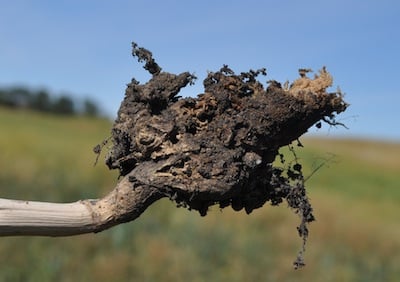
Various labs will test soil for clubroot. Those collecting soil samples are advised to park on the road when possible so the vehicle does not pick up infested soil. Follow sanitation procedures if visiting more than one field. This includes using disposal boot covers for each field and cleaning and disinfecting footwear and tools that come in contact with the soil.
MAFRD provides these soil sampling procedures:
1. Soil samples should be a composite of five, one cup scoops of soil taken at each of five stops in one field. As clubroot concentration have been found to be the highest at field approaches in infected fields, the samples should be taken within the vicinity of where equipment would usually enter into the field. Travelling in a “W” pattern, stop at the five points of the “W” keeping each of these five points at least 20 metres from each other and at least 20 metres from the field edge.
2. Clear away residue from the soil surface, and scoop approximately one cup of the top zero to 10 cm of soil at each site (total one litre from all five sites combined).
3. Air-dry soil samples in paper boxes and send them to a laboratory for DNA testing.
Manitoba’s Plant Surveillance Initiative Lab (PSI Lab) will start taking samples later this month. Grid sampling of Manitoba will start within the week. Growers who want to volunteer their fields for grid sampling or who want to send in their own samples can contact the lab here:
Plant Surveillance Initiative Lab
5A-1325 Markham Road
Winnipeg, MB R3T 4J6
Email: info@mbpestlab.ca
Four other labs in Canada will test soil for clubroot. Find the list here.
